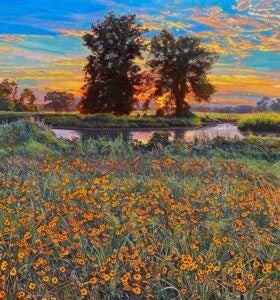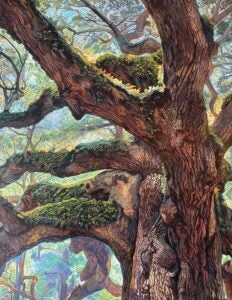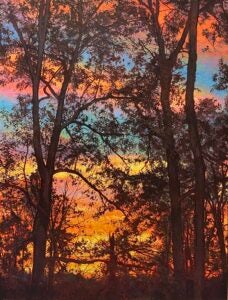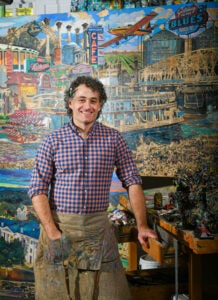Written by Julie Maybus
Photos by Bruce Newman
Often, Oxford feels like a giant treehouse. Situated in the southern foothills of the Appalachian Mountains, the town’s land and surrounding areas rise and fall like undecided ocean currents. A drive down one street can be flat and nondescript. But take a turn, and suddenly, houses sit on hilltops with breathtaking views of small forests or creek gulleys below.
When I turned off a rather mundane part of County Road 217, just east of Oxford, onto North Deer Run Road, I sensed I had slipped down my own rabbit hole into a verdant wonderland of secret hiding places. The home of Charlie Buckley and family sat tucked away in those surroundings, perfect for an artist who loves painting landscapes. Charlie greeted me at the end of his driveway and swept me through the lush surroundings into his studio.
Charlie and his older brother Andrew were born to Tom and Marjorie Buckley while the family lived in Dallas, Texas. Marjorie is an Oxford native with a music teaching degree from Millsaps College. Her journey to marriage, Dallas, and motherhood began with her call to the ministry. Raised a Methodist, Marjorie attended the SMU Perkins School of Theology in Dallas, where she met her Nebraska-native husband. They married a year later, and the pair began a career as co-pastoring  Methodist ministers.
Methodist ministers.
In 1989, when the boys were seven and nine, the Mississippi Methodist Conference offered the couple a joint pastoring opportunity in Newton, Mississippi. The family made the move.
Charlie got very animated as he spoke of Newton. “My happy and overwhelming memory of Newton was Dotty Armstrong. She lived down the street from us in a pink Victorian house with a big bicycle attached to the exterior wall. And she had a swimming pool.” So often, in the life of an artist, a person outside the family is instrumental in shaping the student’s love and talent for the discipline. Dotty taught art at the elementary school, and once a week, starting in the second grade, Charlie walked down the street to that pink house and plied his little seven-year-old art talents through watercolors, arts and crafts, and woodworking in Mr. Armstrong’s home workshop.
After six years in Newton, the Buckleys accepted a co-pastoring opportunity at an Olive Branch church. The city was closer to Marjorie’s parents, Doris and Bo Murry, in Oxford, and the nearby city of Memphis could expose the boys to broader cultural resources.
The Olive Branch middle school had no art classes, but Charlie found ways to keep creating on his own. Once in high school, Charlie’s art teacher, John Chapman, became another great mentor to this dedicated art student.

Charlie finished his senior year in 2000, taking high school honors when he graduated. Charlie announced his decision to major in art at Ole Miss.
In the fall of 2000, he embraced his first year of college with a seriousness and determination to excel. Without a doubt, Ole Miss has a reputation as a party school. But Charlie chose to forego rush and the fraternity life. He saw it as a distraction from his academic goals. But that is not to say his social life suffered. Charlie and Amber Nichols met in high school at Olive Branch but didn’t date then. Serendipity reunited the couple through dorm roommates their freshman year; a romance blossomed, and they married after college graduation.
Charlie’s path through the University was extraordinary. He graduated summa cum laude with a Bachelor of Fine Arts. In addition, he was awarded the Taylor Medal, the University of Mississippi’s highest academic award given to less than 1% of the student body each year.
After graduation, now married, the demand for real-world responsibilities lifted its head  for the couple. It was time to face and test the economic power of his artistic gift. Amber had a three-year commitment to teach in Holly Springs, so the couple stayed in Oxford for that period. Without intention, Charlie was drawn into portrait painting. “I don’t think portraits are my strength, but people came to me for commission work. This period was also when I started painting landscapes and architectural scenes. It was the most consequential time in my life and proved I could make a living from art.”
for the couple. It was time to face and test the economic power of his artistic gift. Amber had a three-year commitment to teach in Holly Springs, so the couple stayed in Oxford for that period. Without intention, Charlie was drawn into portrait painting. “I don’t think portraits are my strength, but people came to me for commission work. This period was also when I started painting landscapes and architectural scenes. It was the most consequential time in my life and proved I could make a living from art.”
After Amber completed her three years in Holly Springs, Charlie accepted a full scholarship to Miami University in Oxford, Ohio, to complete a master’s in fine arts.
“My time immediately after college when I was working as a full-time artist and my time in graduate school in Ohio were very formative. That was the first five years of our marriage. We were broke, idealistic, and working our butts off to build our lives. We believed in each other’s dreams. Those five years were the bedrock of this life.”
With his MFA completed, the couple moved to Tupelo, where Amber took a position teaching high school AP English, and Charlie taught art at Mississippi State, routinely making the hour commute between Tupelo and Starkville. Charlie offered, “I enjoyed teaching in the studio,” but the bureaucratic demands were somewhat off-putting. “I couldn’t stand the meetings, the grading, and the emails.” Charlie wanted to paint.
Ironically, Charlie later interviewed for a teaching position in Chicago. “I bombed the interview. It was a blessing because I really did not want to teach.”
While in Tupelo, Charlie kept up his landscapes. “I loved painting delta soybean fields, especially with standing water after floods. Word got around about my work, and several local businesses commissioned pieces for their offices. By then, he was also regularly showing at Southside Gallery in Oxford and Gallery 119 in Jackson.
As demands for his work grew, Charlie faced a turning point in his career. “That was a real struggle, trying to figure out the right decision–safety in a long-term, stable job–or striking out on my own, again, painting full time. Once I made the choice, I never looked back.
His gallery opportunities flourished. He was asked to show in Nashville and Little Rock. Gradually, a new genre evolved from his multi-dimensional subject matter–cityscapes–grand and diverse paintings encompassing the heart and soul of an urban area.
Charlie’s brother, Andrew, who lives in Atlanta, used his social media platforms to highlight Charlie’s work—and the word spread. The CREATE Foundation in Tupelo, started by George and Anna McLean in 1972, was one of his first collages. In it, Charlie layered portraits of its founders and cultural and architectural aspects of the city of Tupelo to portray an artistic story of the foundation’s impact.
Clients are lining up for their piece of his genius, his cityscapes–he calls them “stacks.” Blair Batson Hospital, First Commercial Bank, and the City of Gulfport are just a few of his clients.
“These projects require a lot of research time. You can’t just start painting. I have to get a feel for the client’s expectations, the history, the architecture before I even begin the sketching. I’m primarily focused on telling a specific Mississippi narrative, and I want to make sure each painting tells its piece of our story as accurately and artistically as possible. Plus, they are big, really big.”
Charlie’s newest project is 13 feet wide by 4.5 feet tall. After he finishes the design steps, the painting will take about six weeks. It’s a secret commission, so we will have to wait to know the genesis of the piece.
This success couldn’t be happening to a nicer family. Charlie and Amber have a thirteen-year-old. Emers is a musician who plays with the Oxford middle school band.
Marjorie shared

Charley Buckley in his studio in Oxford, Miss. on Wednesday, August 28, 2024. (©Bruce Newman)
another story about her son. “Charlie is close with his money. Getting him to buy a house in Oxford took a miracle.” That’s just about what happened. Three years ago, a local pastor and Charlie’s close friend told him about this property in his neighborhood. The owners and the Buckleys struck a deal.
I called it a verdant wonderland. Charlie described it as a neighborhood commune. Same thing. “We all live together as a big family in this stunning, tucked-away space.” For this artist with an eye for his environs, his creations seem to rise and tumble forth like the foothills of this Appalachian terrain.








